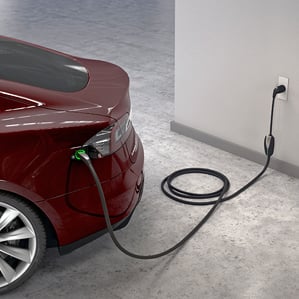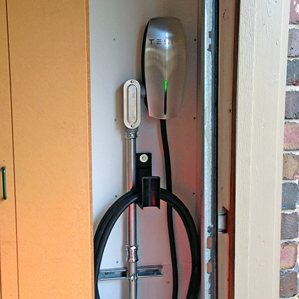Could Electric Cars Threaten the Grid?
Plugging in an electric vehicle is, in some cases, the equivalent of adding three houses to the grid. That has utilities in California—where the largest number of electric vehicles are sold—scrambling to upgrade the grid to avoid power outages.

Last year in the United States, only about 50,000 electric cars were sold. And researchers at the U.S. Department of Energy’s Pacific Northwest National Laboratory have calculated that the grid has enough excess capacity to support over 150 million battery-powered cars, or about 75 percent of the cars, pickups, and SUVs on the road in the United States. But there’s a catch. While power plants and transmission lines have excess capacity, things can get tight when it comes to distributing power to individual neighborhoods. And this is especially the case since electric vehicle sales aren’t evenly distributed. In California, for example, they’re taking off in Silicon Valley and places such as Long Beach and Santa Monica.
Electric cars being sold today can draw two to five times more power when they’re charging than electric cars that came on the market just a couple of years ago. But the impact of charging one depends on where it is on the grid and how it is charged. They don’t pose a problem if they’re charged slowly at conventional 110 volt outlets. And public fast-charging stations don’t impact the grid much because they are part of commercial grids that have transformers and other equipment sized to accommodate large loads.
The trouble arises when electric car owners install dedicated electric vehicle charging circuits. In most parts of California, charging an electric car at one of those is the equivalent of adding one house to the grid, which can be a significant additional burden, since a typical neighborhood circuit has only five to 10 houses. In San Francisco, where the weather is cool and air conditioning is rarely used, the peak demand of a house is much lower than in the hotter parts of California. As a result, the local grid is sized for a much smaller load. A house in San Francisco might only draw two kilowatts of power at times of peak demand, according to Pacific Gas & Electric. In comparison, a new electric vehicle on a dedicated circuit could draw 6.6 kilowatts—and up to 20 kilowatts in the case of an optional home fast charger for a Tesla Model S.

Utilities are keeping a close eye on power demand—via smart meters—to identify neighborhoods that need an upgrade. They’re also working with automakers to get customers to tell them when they buy an electric vehicle—an approach that’s identifying about 40 percent of new electric cars for Southern California Edison.
Utilities say that the upgrades they’ve performed so far would have been made anyway as part of routine grid modernization. But telling the utility that you are buying an electric vehicle essentially brings your neighborhood to the top of the list. The upgrades are paid for by all rate payers, not the electric car owners.
Both PG&E and Southern California Edison are also working to avoid grid problems by offering special rate plans for EV owners. These give customers discounts for charging at night, during off-peak hours.
Electric cars can typically be programmed to charge at certain times, rather than just charging as soon as they’re plugged in. If car owners set their cars to be completely charged by a certain time, say 6 a.m., this has the effect of staggering when cars start charging. The start time depends on how depleted the battery is—to finish at 6 a.m. might require starting at 2 a.m. or 4 a.m., depending on how much charging is needed. So instead of a surge of power demand when people get home from work, the charging is spread out through the night.
It’s technically possible for utilities to communicate with cars to have them start charging when there’s excess power being produced, and stop when there’s a peak in demand. That way, utilities could use electric cars to help stabilize the grid, and avoid the need to use inefficient “peaker” power plants. Utilities could pay electric car owners to let them do this.
But such an approach depends on the choices that electric car owners make. If everyone decides to charge at home right away, and to charge at the fastest rate possible, that could strain the grid.
So far, it looks like most electric vehicle owners are often choosing to charge their vehicles slowly and at night, according to a study of electric vehicle owners by Southern California Edison. But as fast-charging, all-electric cars like the Model S sell in larger numbers, and as automakers seek to differentiate their electric cars by how fast they charge, that story could change.
Deep Dive
Climate change and energy
The problem with plug-in hybrids? Their drivers.
Plug-in hybrids are often sold as a transition to EVs, but new data from Europe shows we’re still underestimating the emissions they produce.
Harvard has halted its long-planned atmospheric geoengineering experiment
The decision follows years of controversy and the departure of one of the program’s key researchers.
Why hydrogen is losing the race to power cleaner cars
Batteries are dominating zero-emissions vehicles, and the fuel has better uses elsewhere.
Decarbonizing production of energy is a quick win
Clean technologies, including carbon management platforms, enable the global energy industry to play a crucial role in the transition to net zero.
Stay connected
Get the latest updates from
MIT Technology Review
Discover special offers, top stories, upcoming events, and more.